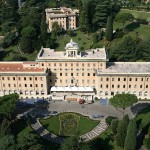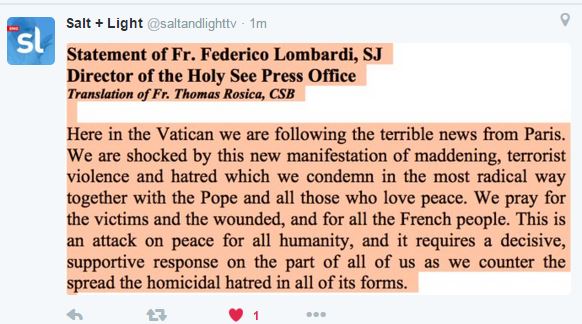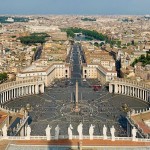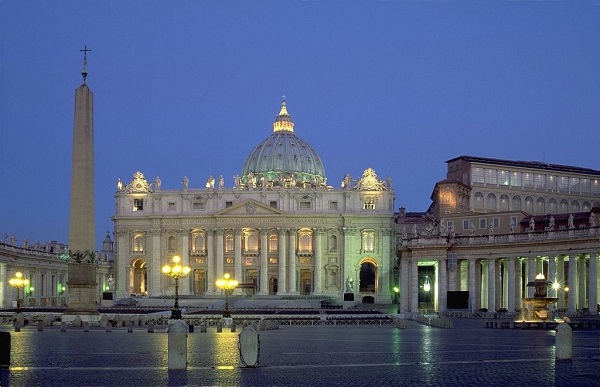Have you ever seen this?
Probably not—This is the coat of arms of the Holy See during the Interregnum, that period after a pope leaves office until a new pontiff is elected by the College of Cardinals. It is also known as the Sede Vacante period, that time when the Seat (the Chair of Peter, that is) is Vacant.
Instead of the papal tiara over the keys, as is customary for the Holy See and the Vatican City State, the tiara is replaced with the umbraculum (ombrellino, in Italian). This symbolizes both the lack of a Pope and also the governance of the Camerlengo over the temporalities of the Holy See. The Camerlengo (Italian for “Chamberlain”) is the Cardinal who manages the pope’s temporal affairs. During the Interregnum, the Camerlengo ornaments his arms with this symbol, which he subsequently removes once a pope is elected.
COAT OF ARMS OF THE HOLY SEE
Under normal circumstances—that is, when there is a pope heading the Church throughout the world—this is the coat of arms of the Holy See (here shown on the Vatican flag):
The Vatican website offers a description of the coat of arms, explaining its symbolism.
The symbolism is drawn from the Gospel and is represented by the keys given to the Apostle Peter by Christ.
The insignia is red with the two keys crossed as the Cross of St. Andrew, one gold and one silver, with the cotter pointed upwards and towards the sides of the shield. Two cords hang from the grips of the keys, usually red or blue.
The shield is surmounted by the tiara or triregnum.
Two ribbons hang from the tiara, each with a patent cross.
Ordinarily the keys have the mechanical part placed up, facing to the right and the left and usually in the form of a cross, not for the mechanisms of a lock, but as a religious symbol. The grips vary according to artistic taste, from the Gothic to the Baroque.
Since the XIV Century, the two crossed keys have been the official insignia of the Holy See. The gold one, on the right, alludes to the power in the kingdom of the heavens, the silver one, on the left, indicates the spiritual authority of the papacy on earth. The mechanisms are turned up towards the heaven and the grips turned down, in other words into the hands of the Vicar of Christ. The cord with the bows that unites the grips alludes to the bond between the two powers.
THE PAPAL COAT OF ARMS
Perhaps more familiar than the Holy See’s coat of arms is that of the current pope. We’ll be seeing a new coat of arms once the next pope is elected; but here is the coat of arms which has represented Pope Benedict XVI, and which will quite possibly fly above the residence of Benedict XVI, Bishop-emeritus of Rome, in the Vatican Gardens.
Again, the Vatican website offers a comprehensive explanation of its features:
The shield chosen by Pope Benedict XVI is very simple: it is in the shape of a chalice, the most commonly used form in ecclesiastical heraldry.
The field of Pope Benedict XVI’s shield, different from the composition on his shield as Cardinal, is now gules (red), chape or (gold). The principal field, in fact, is red.
In each of the upper corners there is a “chape” in gold. The “chape” [cape] is a symbol of religion.It indicates an idealism inspired by monastic or, more specifically, Benedictine spirituality. Various Orders and Congregations, such as the Carmelites and the Dominicans, have adopted in their arms the form of the “chape”, although the latter only used it in an earlier form rather than their present one. Benedict XIII (1724-1730) of the Order of Preachers used the “Dominican chief” [heraldic term: upper part of the field] which is white divided by a black “chape”.
Pope Benedict XVI’s shield contains symbols he had already used in his arms when he was Archbishop of Munich and Freising, and subsequently as Cardinal. However, they are arranged differently in the new composition.
The principal field of the coat of arms is the central one which is red. At the point of honour of the shield is a large gold shell that has a triple symbolism.
Its first meaning is theological. It is intended to recall a legend attributed to St Augustine. Meeting a child on the beach who was trying to scoop up the sea into a hole in the sand, Augustine asked him what he was doing. The child explained his vain attempt and Augustine took it to refer to his own futile endeavour to encompass the infinity of God within the confines of the limited human mind.
The legend has an obvious spiritual symbolism; it is an invitation to know God, yet with the humility of inadequate human understanding, drawing from the inexhaustible source of theology.
The scallop shell, moreover, has been used for centuries to distinguish pilgrims. Benedict XVI wanted to keep this symbolism alive, treading in the footsteps of John Paul II, a great pilgrim to every corner of the world. The design of large shells that decorated the chasuble he wore at the solemn liturgy for the beginning of his Pontificate, Sunday, 24 April, was most evident.
The scallop is also an emblem that features in the coat of arms of the ancient Monastery of Schotten near Regensburg (Ratisbon) in Bavaria, to which Joseph Ratzinger feels spiritually closely bound.
In the part of the shield called “chape”, there are also two symbols that come from the Bavarian tradition which Joseph Ratzinger introduced into his coat of arms when he became Archbishop of Munich and Freising in 1977.
In the dexter corner (to the left of the person looking at it) is a Moor’s head in natural colour [caput Aethiopum] (brown) with red lips, crown and collar. This is the ancient emblem of the Diocese of Freising, founded in the eighth century, which became a Metropolitan Archdiocese with the name of München und Freising in 1818, subsequent to the Concordat between Pius VII and King Maximilian Joseph of Bavaria (5 June 1817).
The Moor’s head is not rare in European heraldry. It still appears today in the arms of Sardinia and Corsica, as well as in the blazons of various noble families. Italian heraldry, however, usually depicts the Moor wearing a white band around his head instead of a crown, indicating a slave who has been freed; whereas in German heraldry the Moor is shown wearing a crown. The Moor’s head is common in the Bavarian tradition and is known as the caput Ethiopicum or the Moor of Freising.
A brown bear, in natural colour, is portrayed in the sinister (left) corner of the shield, with a pack-saddle on its back. An ancient tradition tells that the first Bishop of Freising, St Corbinian (born c. 680 in Châtres, France; died 8 September 730), set out for Rome on horseback. While riding through a forest he was attacked by a bear that tore his horse to pieces. Corbinian not only managed to tame the animal but also to make it carry his baggage to Rome. This explains why the bear is shown carrying a pack. An easy interpretation: the bear tamed by God’s grace is the Bishop of Freising himself; the pack saddle is the burden of his Episcopate.














